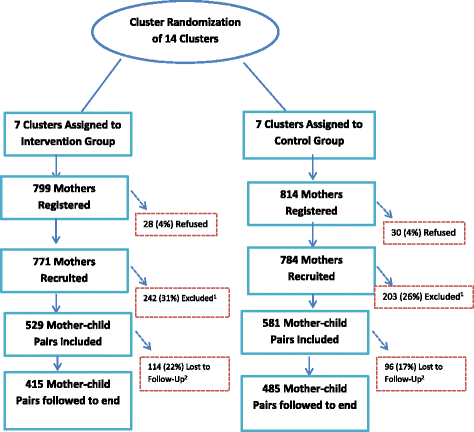Effectiveness of home-based nutritional counselling and support on exclusive breastfeeding in urban poor settings in Nairobi: a cluster randomized controlled trial
- PMID: 29258549
- PMCID: PMC5735795
- DOI: 10.1186/s12992-017-0314-9
Effectiveness of home-based nutritional counselling and support on exclusive breastfeeding in urban poor settings in Nairobi: a cluster randomized controlled trial
Abstract
Background: Exclusive breastfeeding (EBF) improves infant health and survival. We tested the effectiveness of a home-based intervention using Community Health Workers (CHWs) on EBF for six months in urban poor settings in Kenya.
Methods: We conducted a cluster-randomized controlled trial in Korogocho and Viwandani slums in Nairobi. We recruited pregnant women and followed them until the infant's first birthday. Fourteen community clusters were randomized to intervention or control arm. The intervention arm received home-based nutritional counselling during scheduled visits by CHWs trained to provide specific maternal infant and young child nutrition (MIYCN) messages and standard care. The control arm was visited by CHWs who were not trained in MIYCN and they provided standard care (which included aspects of ante-natal and post-natal care, family planning, water, sanitation and hygiene, delivery with skilled attendance, immunization and community nutrition). CHWs in both groups distributed similar information materials on MIYCN. Differences in EBF by intervention status were tested using chi square and logistic regression, employing intention-to-treat analysis.
Results: A total of 1110 mother-child pairs were involved, about half in each arm. At baseline, demographic and socioeconomic factors were similar between the two arms. The rates of EBF for 6 months increased from 2% pre-intervention to 55.2% (95% CI 50.4-59.9) in the intervention group and 54.6% (95% CI 50.0-59.1) in the control group. The adjusted odds of EBF (after adjusting for baseline characteristics) were slightly higher in the intervention arm compared to the control arm but not significantly different: for 0-2 months (OR 1.27, 95% CI 0.55 to 2.96; p = 0.550); 0-4 months (OR 1.15; 95% CI 0.54 to 2.42; p = 0.696), and 0-6 months (OR 1.11, 95% CI 0.61 to 2.02; p = 0.718).
Conclusions: EBF for six months significantly increased in both arms indicating potential effectiveness of using CHWs to provide home-based counselling to mothers. The lack of any difference in EBF rates in the two groups suggests potential contamination of the control arm by information reserved for the intervention arm. Nevertheless, this study indicates a great potential for use of CHWs when they are incentivized and monitored as an effective model of promotion of EBF, particularly in urban poor settings. Given the equivalence of the results in both arms, the study suggests that the basic nutritional training given to CHWs in the basic primary health care training, and/or provision of information materials may be adequate in improving EBF rates in communities. However, further investigations on this may be needed. One contribution of these findings to implementation science is the difficulty in finding an appropriate counterfactual for community-based educational interventions.
Trial registration: ISRCTN ISRCTN83692672 . Registered 11 November 2012. Retrospectively registered.
Keywords: Child nutrition; Cluster randomized controlled trials; Exclusive breastfeeding; Infant feeding practices; Kenya; Sub-Saharan Africa; Urban slums.
Conflict of interest statement
Ethics approval and consent to participate
Ethical approval was granted by the Kenya Medical Research Institute (KEMRI) Ethical Review Committee (Reference number: KEMRI/RES/7/3/1). Written informed consent was obtained from all participants. Proxy consent for children was obtained from their mothers.
Consent for publication
No individual person data is included in this manuscript.
Competing interests
The authors have no competing interests to declare.
Publisher’s Note
Springer Nature remains neutral with regard to jurisdictional claims in published maps and institutional affiliations.
Figures

References
Publication types
MeSH terms
Grants and funding
LinkOut - more resources
Full Text Sources
Other Literature Sources
Medical

